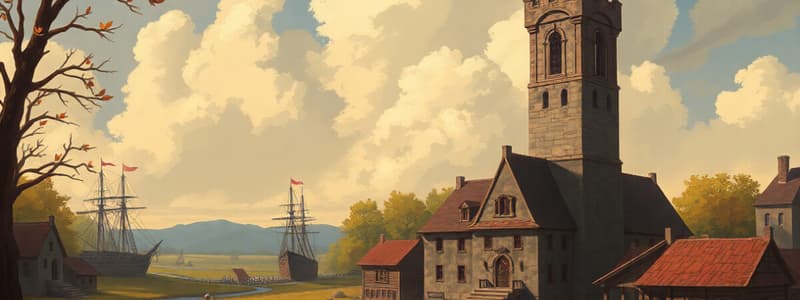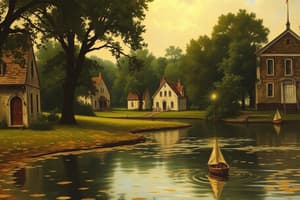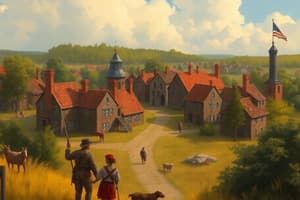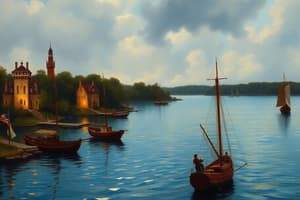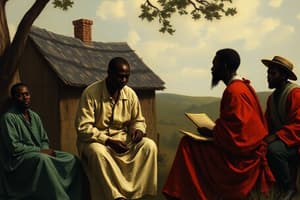Podcast
Questions and Answers
Explain how the transition from tobacco to rice cultivation impacted the demographics and labor systems of South Carolina.
Explain how the transition from tobacco to rice cultivation impacted the demographics and labor systems of South Carolina.
The shift to rice led to an increased demand for enslaved Africans who possessed the knowledge of rice cultivation, drastically increasing the enslaved population and solidifying the plantation system.
Analyze the significance of the Toleration Act of 1649 in Maryland. What broader implications did it have for religious freedom in the colonies, and how was it eventually undermined?
Analyze the significance of the Toleration Act of 1649 in Maryland. What broader implications did it have for religious freedom in the colonies, and how was it eventually undermined?
The Toleration Act initially provided religious freedom to all Christians, setting a precedent for religious tolerance. However, it was later undermined when the Anglican Church became the official church, diminishing the intended broad religious freedom.
Explain how the Calvert family's religious beliefs influenced their decision to found the Maryland Colony, and what specific challenges did they hope to address by establishing this colony?
Explain how the Calvert family's religious beliefs influenced their decision to found the Maryland Colony, and what specific challenges did they hope to address by establishing this colony?
The Calverts, being Catholic, aimed to create a refuge for Catholics facing religious intolerance in England, alongside generating profit.
Contrast the governmental structures of Virginia and Maryland, highlighting the roles of the governors and elected assemblies. How did the control differ between these two colonies?
Contrast the governmental structures of Virginia and Maryland, highlighting the roles of the governors and elected assemblies. How did the control differ between these two colonies?
Discuss the challenges faced by the Lords Proprietors in governing the Carolina Colony, considering the diverse interests and geographic distribution of the colonists.
Discuss the challenges faced by the Lords Proprietors in governing the Carolina Colony, considering the diverse interests and geographic distribution of the colonists.
In what ways did Cecilius and Leonard Calvert apply lessons learned from the Jamestown colony to ensure the success and stability of the Maryland Colony?
In what ways did Cecilius and Leonard Calvert apply lessons learned from the Jamestown colony to ensure the success and stability of the Maryland Colony?
Evaluate the impact of indentured servitude on the social and economic structures of Maryland. How did the government's support for former servants shape the colony's development?
Evaluate the impact of indentured servitude on the social and economic structures of Maryland. How did the government's support for former servants shape the colony's development?
Detail the original vision for the Maryland Colony. How did the religious and political realities of the late 1600s challenge or alter this original vision?
Detail the original vision for the Maryland Colony. How did the religious and political realities of the late 1600s challenge or alter this original vision?
What motivated George Calvert to request a charter for a new colony from King Charles I, and how did this request reflect the political and economic dynamics of England at the time?
What motivated George Calvert to request a charter for a new colony from King Charles I, and how did this request reflect the political and economic dynamics of England at the time?
Describe the role of indentured servants in the initial colonization of Maryland, and infer how their presence shaped the socio-economic structure of the colony compared to other models of colonization.
Describe the role of indentured servants in the initial colonization of Maryland, and infer how their presence shaped the socio-economic structure of the colony compared to other models of colonization.
Flashcards
Founding of Maryland
Founding of Maryland
The Calvert family, wealthy English landowners, founded Maryland. They sought profit and a refuge for Catholics.
Cecilius Calvert
Cecilius Calvert
Cecilius Calvert became Lord Baltimore after his father's death and owned the Maryland colony.
Leonard Calvert
Leonard Calvert
Leonard Calvert was the first governor of Maryland, appointed by his brother Cecilius.
Maryland's First Colonists
Maryland's First Colonists
Signup and view all the flashcards
St. Mary's City
St. Mary's City
Signup and view all the flashcards
Virginia and Maryland governments similarities
Virginia and Maryland governments similarities
Signup and view all the flashcards
Maryland Toleration Act (1649)
Maryland Toleration Act (1649)
Signup and view all the flashcards
Maryland's support for former indentured servants
Maryland's support for former indentured servants
Signup and view all the flashcards
Carolina Colony
Carolina Colony
Signup and view all the flashcards
South Carolina's key crop
South Carolina's key crop
Signup and view all the flashcards
Study Notes
- The Maryland Colony was founded by the Calverts, a wealthy English Catholic family.
- The Calverts wanted to create a profitable colony and a refuge for Catholics, who could not freely worship in England.
The Calverts
- George Calvert, or Lord Baltimore, invested in the Virginia Company.
- Calvert requested a charter from King Charles I for a colony north of Virginia along Chesapeake Bay.
- George Calvert died in 1632 before the charter was signed.
- Cecilius Calvert, George's oldest son, inherited the charter and became the new Lord Baltimore.
- Cecilius named the colony Maryland.
- Leonard Calvert, Cecilius's brother, was chosen as Maryland's first governor.
- The Calvert brothers learned from the difficulties at Jamestown and carefully planned their colony to avoid "starving time."
- In 1633, the Calverts sent the first colonists to Maryland, most of whom were indentured servants.
- The colonists landed near the mouth of the Potomac River and founded their first settlement, St. Mary's City.
- Maryland and Virginia were neighboring colonies with a mild climate, separated by the Chesapeake Bay and Potomac River.
- Tobacco thrived in the fertile soil of the Coastal Plain.
- While some Maryland colonists grew rich from large tobacco plantations, most struggled on small farms as indentured servants.
- The Maryland government assisted former servants by providing them with land, clothing, tools, and corn.
- Both Virginia and Maryland had governors and elected assemblies.
- The king controlled the royal colony of Virginia, whereas the Calverts controlled Maryland as a proprietary colony.
- The Toleration Act was passed in Maryland (1649), granting religious freedom to all Christians.
- The Anglican Church became the colony's official church in 1702.
The Carolina Colonies
- Colonists moved south from Maryland and Virginia to acquire more land.
- King Charles II granted land for the Carolina colony in 1663.
- The Carolina charter divided the colony among eight English leaders, the Lords Proprietors.
- In 1669, a constitution was adopted, allowing free white male colonists to elect leaders and create laws, although the proprietors and the king mostly held the power.
- The Carolina Colony became difficult to govern due to its size and colonists disregard for laws.
- In 1712, the Lords Proprietors split the colony into North Carolina and South Carolina.
- North Carolina farmers grew tobacco and corn.
- South Carolina farmers struggled with tobacco due to wet land.
- Enslaved African workers introduced rice cultivation techniques.
- Rice became South Carolina's main crop, which increased the need for enslaved people.
Georgia
- England, France, and Spain claimed the area south of South Carolina.
- King George II aimed to establish control by sending colonists to colonize the area in 1727.
- James Oglethorpe proposed settling the area with English debtors, who were imprisoned for owing money.
- Debtor-settlers would defend the land and have a chance for a new life.
- Oglethorpe was granted a charger from King George II to colonize the last of the 13 English colonies, named Georgia after the King.
- The first group of colonists founded Savannah in 1733.
- Initially, Georgia restricted farm sizes and prohibited slavery.
- In 1751, Georgia's leaders legalized slavery.
- Georgia's economy grew to depend on plantations and the labor of enslaved Africans, similar to the other Southern Colonies.
Heading West
- In the early 1700s, most English colonies towns, farms, and plantations were established near the coast on the Coastal Plain.
- Few colonists inhabited the Piedmont, the land between the Coastal Plain and the Appalachian Mountains.
- The land was called the backcountry because it was beyond the area settled by Europeans.
- The dense forests, steep slopes, and limited roads made reaching the backcountry challenging.
- By the mid-1700s, numerous settlers moved west of the Coastal Plain.
- Large communities of German immigrants from Pennsylvania settled in the Virginian and Carolinian backcountry.
- Settlers followed a Native American Trail that eventually widened for wagons and became known as the Great Wagon Road.
- The Great Wagon Road traversed the Shenandoah Valley and the eastern side of the Blue Ridge Mountains.
- This road provided the primary route for transporting household goods to the backcountry.
Conflicts with Native Americans
- Thousands of Cherokee, Creek, Powhatan, and other Native American tribes lived in the Southern Colonies region.
- As Europeans arrived, they established settlements on Native American land. This led to conflicts.
- German and Swiss settlers in North Carolina destroyed a Tuscarora village to build their own settlement.
- Some colonists believed that the remaining Native Americans were not treated fairly.
- In 1711, land losses led the Tuscarora to attack settler settlements.
- The attacks led The Tuscarora War finally ended in 1713, where 950 Tuscarora people were killed or captured and sold into slavery.
- Settlers in the Southern Colonies kept displacing Native Americans off their lands.
- Some Native Americans were captured and sent to the West Indies to work on sugarcane plantations.
- Many others died due to fighting colonists over land or trade.
- Even peaceful Native American groups suffered greatly.
Studying That Suits You
Use AI to generate personalized quizzes and flashcards to suit your learning preferences.
